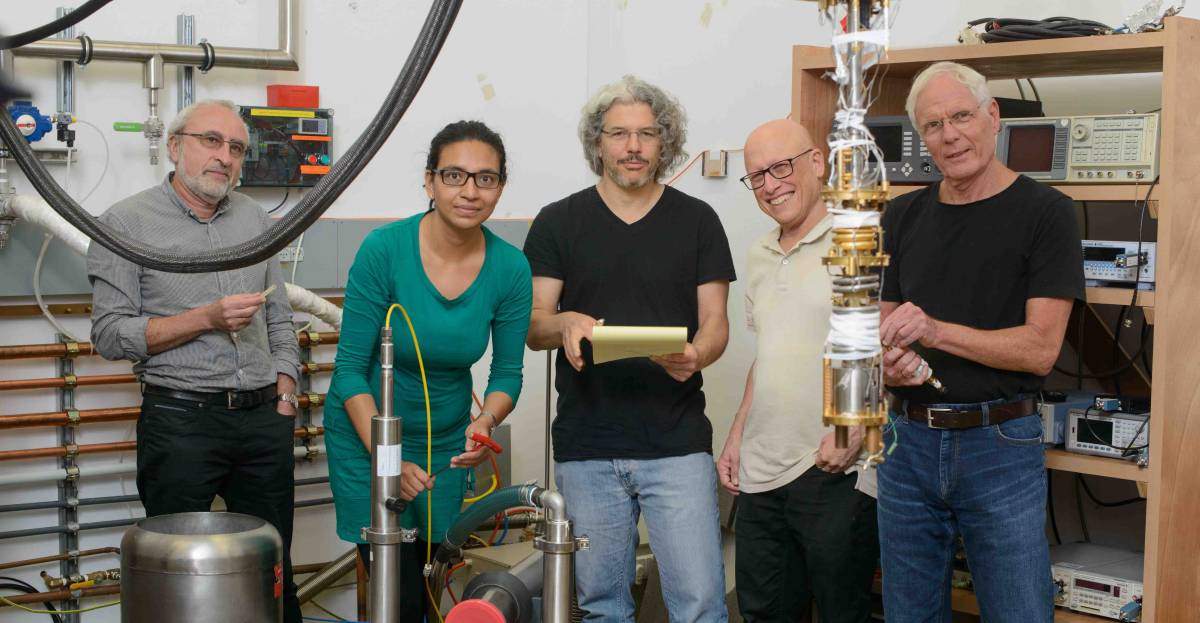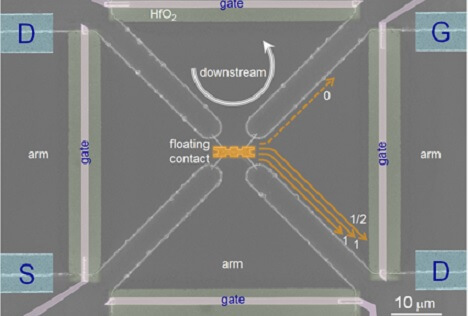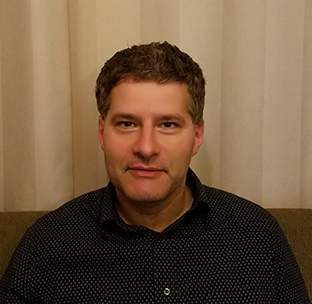Are there non-Abelian particles in the quantum Hall effect that can be used to create quantum bits?

For about three decades, the world of condensed matter physics has been fascinated by the wealth of phenomena associated with the topological states of matter. The richest example in this field is the quantum Hall effect. This phenomenon takes place in electronic systems where electrons are limited to flow in two dimensions only. When the system is subjected to the influence of a magnetic field that is perpendicular to the plane of motion of the electrons, a voltage appears in the plane, perpendicular to the direction of the current. This voltage is called the Hall voltage, and the relationship between it and the current is called the Hall resistance, which was discovered already in the 19th century.
The quantum aspect of the phenomenon was discovered about three decades ago. First, it was discovered that the Hall resistance takes on a series of "quantized" values, which repeat themselves, in different materials, in different samples and under different conditions. These values are repeated to the nearest one in a billion. But, as was understood over years of research, both theoretical and experimental, the phenomenon includes many more surprises, chief among them the broken charge and the broken statistics. Although the system is an electronic system, made of particles (electrons) that carry the same charge, it is able to behave as if it had particles whose electric charge is a fraction of the electron's charge. These particles, called "quasi particles", can only exist within the system. However, even there their existence entails many consequences. One of them is the broken charge, and this name also explains its nature.

Two types of particles are known in nature, the difference between which is expressed, among other things, in their statistical properties: fermions (named after the physicist Enrico Fermi), and bosons (named after the physicist Satindra Nath Bose). The electron is a fermion, meaning a particle of matter. The photon is a boson, that is, a force-carrying particle. Surprisingly, the simulated particles in quantum Hall systems break this dichotomous division, creating many other types of behavior. The most exotic among these behaviors is the "non-mourning" statistic. There are several theoretical predictions about the existence of non-Abelian particles in the quantum Hall effect. If such particles exist, they can be used to create quantum bits (Q-bits) - the basic units for the operation of a quantum computer. The coherence of these particles is expected to be maximal, because their interaction with the environment is very weak. This fact makes it difficult for the scientists who are trying to prove in experiments the existence of such particles.
Previous theoretical calculations were carried out under the working assumption of a "clean ideal system". But in practice, no system is completely clean. As no one is perfect, neither are there perfect materials"
A group of physicists from the Department of Condensed Matter Physics at the Weizmann Institute of Science, including the post-doctoral researcher Dr. Mitali Banerjee, Prof. Motty Highbloom, Prof. Yuval Org, Prof. Adi Stern, staff scientist Dr. Vladimir Umansky, and with them Prof. Dmitri (Dima) Feldman from Brown University in the United States, was recently able to show in an experiment, that one of the states of the quantum Hall effect is indeed non-Abelian. The systems where non-Abelian particles are expected to appear are systems that are very difficult to create. To do this, extremely clean semiconductor materials, at extremely low temperatures, and extremely complex experimental techniques are needed. Dr. Vladimir Umansky from Prof. Hyblum's research group, is the "world champion" in the production of very clean (or pure) crystals of the semiconductor gallium arsenium. In the submicron center at the Weizmann Institute, scientists can cool materials to temperatures of 10-20 thousand degrees above absolute zero. For the purpose of the experiment, Dr. Mitli Banerjee and Prof. Moti Highblom developed a special system that measures the thermal conductivity of the electrons participating in the phenomenon (flow of heat current due to temperature differences), since this conductivity carries the signs of the non-Abelian state. Prof. Highblom says that this conductivity is "quantized", that is, it is carried out on the basis of fixed units, and not in a changing sequence, when abelian particles carry whole units, while the non-Abelian particles carry broken units.

The experiment did show broken thermal conductivity; That is, the studied situation is a non-mourning situation, as predicted by the theory. However, to the researchers' surprise, it turned out that the non-Abelian particles were of a different type than expected. Theorists Prof. David Maros, Prof. Yuval Org, Prof. Adi Stern, and research student Gilad Margalit offer an explanation for this surprising result. Previous theoretical calculations were carried out under the assumption that there is a "clean ideal system". But in practice, no system is completely clean. The expression "clean system" reflects the degree of purity of the crystal of the semi-conducting material from which the system of the fractional quantum Hall effect is built. But there are always impurities in the crystals, and there is variation in the level of purity in different areas of them, so in practice, the crystals are not "ideal". In other words, just as no one is perfect, neither are there perfect materials. Thus, the theorists introduced into their calculations a non-ideal purity of the system's crystals, and then received a prediction that matched the result obtained in the laboratory. Moreover, they discovered that although the purity of the crystal is usually a necessary condition for the realization of a non-mourning state, there can also be circumstances in which it is actually imperfect purity that will cause such a state to form.
|
The unit constant of heat flowing in the quantum Hall effect system is equal to 0.000000000001 Watt, divided by 1 Kelvin squared. #Science_Numbers
|

One response
The article tries to adhere to the physical accuracy and to explain even complex terms simply. Good luck with that.